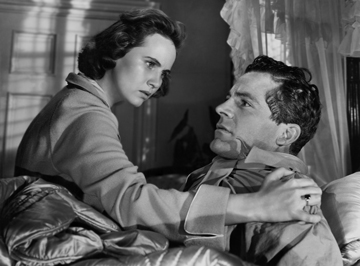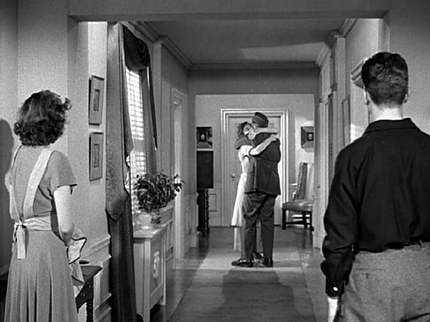
 |
|
|
|
The truth be told, the films in the Goldwyn Library haven't been treated very well on DVD. Although many are genuine classics, MGM may not have released any on Blu-ray. The majority were filmed in kid-allergic B&W. Most twenty-something disc buyers of the new Millennium don't even know who Danny Kaye was, and trying to interest a mass audience in great pictures like Come and Get It or Ball of Fire is too much trouble. Warner Home Video has the Goldwyn Library now. Even though I'm not holding my breath for a massive restoration of an item like Otto Preminger's 1959, 65mm Porgy and Bess, WB is making headway on the top titles. William Wyler's 1946 The Best Years of Our Lives is a fine place to start. One of mainstream Hollywood's most enduring classics, it's and a key film about America immediately after WW2. Victory was ours and peace and prosperity beckoned, but returning veterans encountered unexpected problems. What had happened? With the Allied victory Hollywood took a much-needed break from war themed pictures. It was thought that the public preferred escapism, which made Sam Goldwyn and William Wyler's commitment to MacKinlay Kantor's novel Glory For Me a commercial long shot. Little did anyone know that their film would capture the heart of the nation, while adding the category of 'socially conscious' to the kinds of movies the public would accept. Just as Casablanca had struck an emotional nerve, millions saw their own hopes and dreams in The Best Years of Our Lives. 
Three servicemen return to the small Midwest town of Boone City and form a bond during their 'period of readjustment'. Infantry sergeant Al Stephenson (Fredric March) reunites with his loving family, but his kids have grown so much that they seem like strangers. Back at work, he finds his bank job incompatible with the cooperative spirit he felt during the war, and turns to drink. Sailor Homer Parrish (Harold Russell) lost both of his hands in battle. He shuns the pity of his parents and misinterprets the love of Wilma Cameron (Cathy O'Donnell), his high school sweetheart and literal girl next door. After being responsible for entire missions, bombardier Fred Derry (Dana Andrews) feels like damaged goods because he's unqualified for a respectable job. His party-girl war bride Marie (Virginia Mayo) now has little use for him, and he's drawn to Al's daughter, Peggy (Teresa Wright). When Peggy announces that she's going to break up Fred's marriage, even her mother Milly (Myrna Loy) knows that Fred's straying, Homer's depression and Al's drinking are related problems. The Best Years of Our Lives is one of those film so perfectly cast that one can't imagine it with other actors. It expresses liberal America's reaction to the immediate post-war period, just before the frost of the Cold War set in. Audiences must have been disappointed when victory brought new problems they hadn't expected. The men they got back from overseas didn't seem to be the same boys they had sent away. The mood became one of vague disillusion. What was it all about, when a generation had given so much and life had improved so little? A lot of the content of Best Years was daring stuff. Until the recent The Lost Weekend, the unyielding Production Code had made most serious representations of alcoholism taboo. Real physical imperfection had also been banished from screens since the days of Freaks. When the movie engaged a real double amputee to represent the hundreds of thousands of maimed veterans, it was feared that audiences would find the idea distasteful. The emasculation of the Fred Derry character and his flirtation with the wholesome Peggy also raised eyebrows. Finally, the movie's presentation of callous bankers and a hostile work environment was considered by some to be anti-American propaganda, the kind of provocation that wouldn't be tolerated just a few years later. Weighing in at almost three hours, Best Years is gripping from the first scene to its last -- and with no intermission. Every major character is a multi-dimensional human with faults and problems, strengths and limitations. The town of 'Boone City' is no idealized Andy Hardy-land but a place of small minds and tight jobs, as Fred Derry discovers when he has to return to a humiliating position as a soda jerk. Daughter Peggy learns that love won't solve all problems when her attempt to "break up" Fred's marriage fizzles. More disillusion follows after her parents reveal that their own marriage hasn't been any picnic. Homer Parrish is dismayed to learn that his handicap is a major emotional obstacle, even with his own family. And banker Al Stephenson begins to question an economic system that refuses to help the very veterans who fought to keep the nation together. 
Director William Wyler had an extremely delicate touch. His sensitive treatment of melodramatic movies like Jezebel, The Little Foxes, The Letter and Dodsworth were widely admired. Wyler's cast doesn't necessarily underplay, but a sense of realism comes across, a feeling of ordinary lives being lived. The script and direction treat all of the characters with respect: the well-to-do Stephensons in their luxury apartment, the middle-class Parrishes in their modest neighborhood and the dirt-poor Fred Derry, who lives literally on the wrong side of the tracks. 1 Only bosses and bankers are presented with disapproval. That Al Stephenson's boss is shown to be lacking as a philanthropist seems unfair. As Al had to make loans on the basis of collateral before the war, his sudden moral outrage comes off as self-indulgent. The only real villain is a right-wing radical who causes a commotion at the soda fountain. Played by Ray Teal, the go-to actor for bigots and vigilantes, the radical tells Homer that he lost his hands for nothing, and insists that we should have been fighting the Reds instead of the Nazis and the Japanese. Conservative viewers surely thought much of the movie to be a stacked deck. But it never comes off as leftist propaganda, if only because of Wyler's even hand. A Soviet movie might also show an amputee using his hooks to strike a match, to express the indomitable spirit and sacrifice of the Russian fighting man. But a Russian film wouldn't give us the looks of doubt that flash across Fred and Al's faces when they consider Homer's future. Yet the warm human feelings in The Best Years of Our Lives would earn consensus support in any sample of ordinary Americans. The unglamorous treatment given Homer and Wilma's story has never seemed anything less than 100% heartfelt. A wholesome small-town America really existed, once upon a time. The movie shows the state of things before PTSD, sensitivity training and crisis counseling. Homer's kid sister doesn't worry about his hand-hooks until her father makes her feel guilty about them, passing on his own fear and revulsion. 5 Hollywood had made realistic and even downbeat domestic dramas before, but Sherwood and Wyler caught the pulse of the moment, the story that America accepted as the unvarnished truth. Even the normally glamorous Myrna Loy seems older and more domestic. She's entirely unlike Claudette Colbert's swank-o society woman in Selznick's glamorized Since You Went Away. An interesting real-time wedding ceremony features a signature Wyler staircase. The setting is just a plain frame house with old furnishings, but Wyler doesn't judge the people who live there any more than he does Fred's father, who lives in a veritable shack. Virginia Mayo's Marie is thoughtless and shallow, and could easily have been set up to take the blame for Fred's problems, yet we come to realize that she's just as much a victim of the wartime distortion of values as Fred is. When the glamorous flying officers came through town the home front could be a party, and many couples were married after scarcely a few hours together. It's no wonder that Marie judges the real Fred Derry a big nothing.2 
The great talent Gregg Toland (The Grapes of Wrath, Citizen Kane) contributes first-class camerawork. Some dramatic moments employ dynamic cinematic devices, as with the rapid trucking shots that underscore Fred's emotional breakdown in a mothballed B-17. Wyler likes to keep things "wide". He stages several impressive scenes in deep focus, disposing of the necessity for cutting. The most famous is Al's homecoming in his apartment house, a hallway reunion displayed like a Norman Rockwell painting, but in depth. 3 We witness Al and Milly's embrace from a discreet distance, and in just one shot the family is established as loving and solid. Later, Fred Derry makes a crucial phone call in the bar, seen only as a background detail while Homer and his uncle Butch Engle (Hoagy Carmichael) play piano in the extreme foreground. Al stands by the piano but turns his attention back to the phone booth, his eye-line joining the two visual planes. Greg Toland's fine camerawork makes both shots into complex works of art, that don't draw attention to themselves as gimmicks. While rationalizing the commercial failure of It's a Wonderful Life in his autobiography, Frank Capra gives grudging praise to his Oscar competitor Best Years. He likens Wyler's film to the trend of mean-spirited, despairing crime thrillers of the late '40s that he found to be such an abomination. Yet Capra's Wonderful Life contains a highly stylized noir episode, the alternate-universe vision of an Evil Bedford Falls. It would seem that Capra could only engage with this new kind of disillusion and anxiety on an unconscious level. Although the movies are as different as night and day, when Wyler and Capra need to cast an unpleasant banking bureaucrat, they both turn to the same actor, Charles Halton. Wyler definitely went in an opposite direction from Capra. Even his title places the 'wonderful' part of Life in the past tense. The Best Years of Our Lives is warm but never goes soft and never settles for greeting-card solutions to its problems. It dares to show that middle class life can be less than glamorous. Fred and Peggy share their first kiss in a crummy parking lot, under an ugly industrial storage tank. The conclusion is a noirish blend of optimism and bitterness, with the lovers fully aware of the challenges they'll face. The final dialogue line, delivered in a romantic clinch, is a hardboiled gem: "You know what it'll be like, don't you Peggy? It may take years to get anywhere. We'll have no money. No decent place to live. We'll have to work, get kicked around." Fade out. |
|||||||||||||||||||
Review Staff | About DVD Talk | Newsletter Subscribe | Join DVD Talk Forum
Copyright © MH Sub I, LLC dba Internet Brands. | Privacy Policy
Subscribe to DVDTalk's Newsletters
|